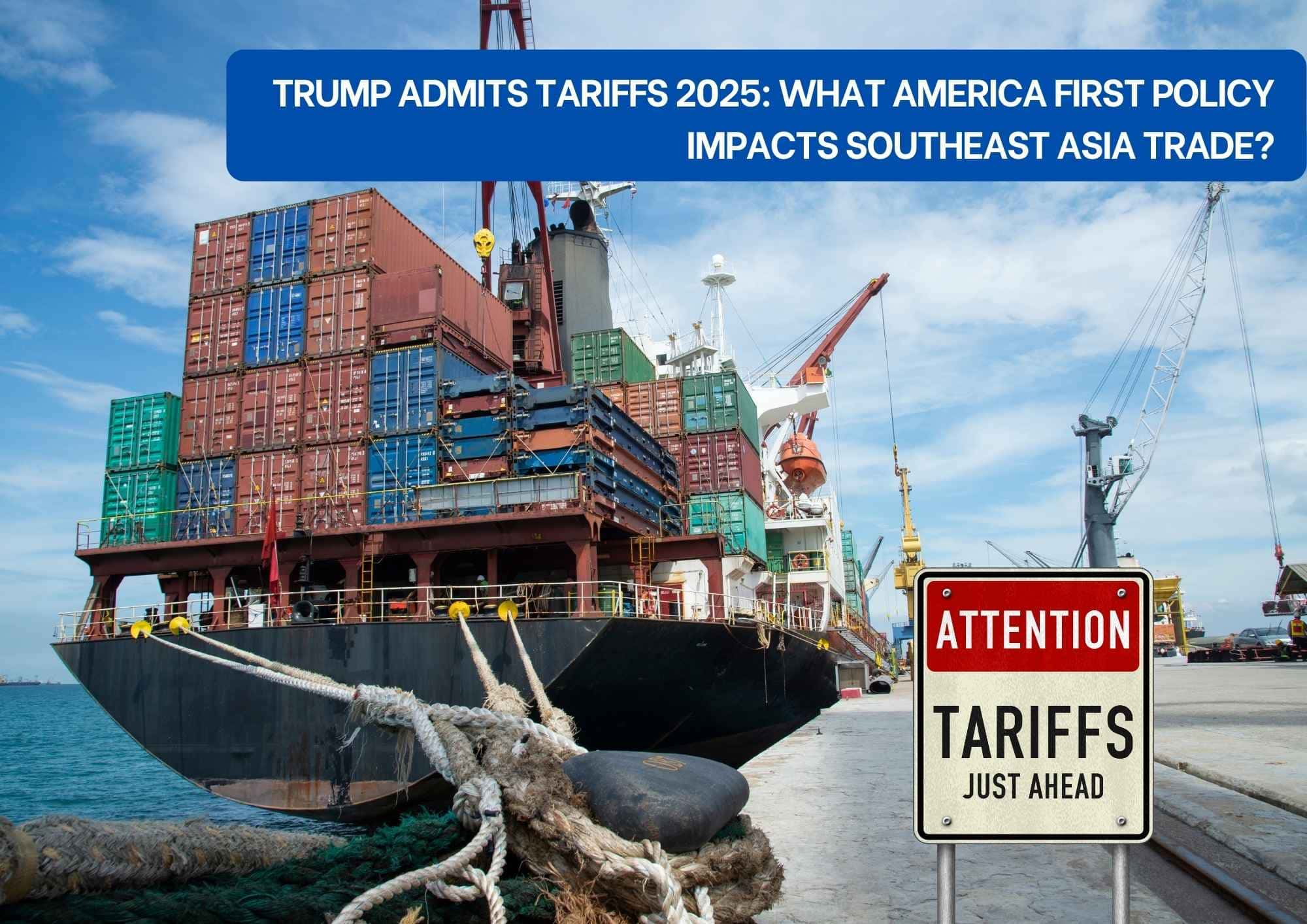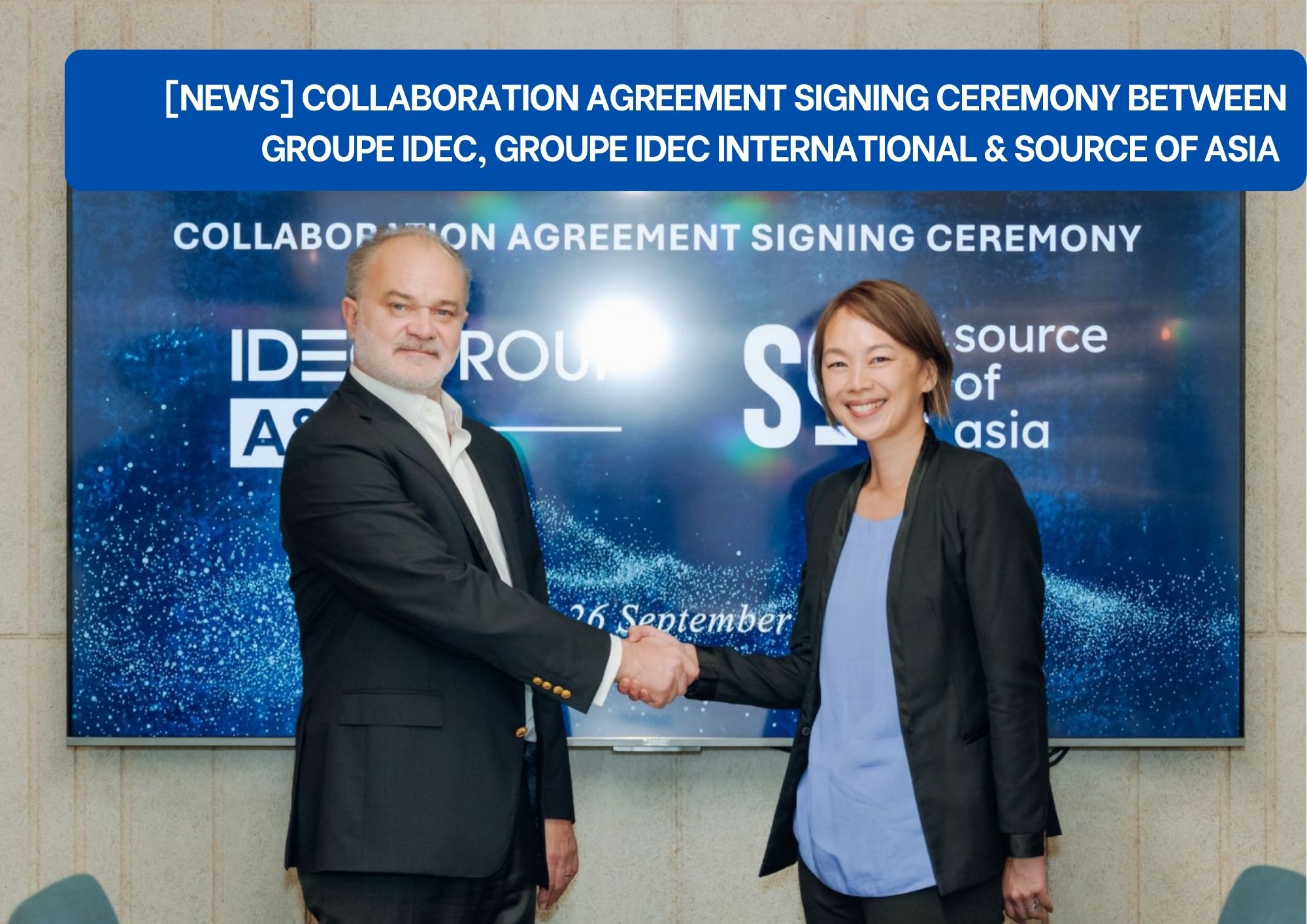Introduction
Donald Trump’s return to the White House in 2025 has once again pushed trade to the top of Washington’s agenda. His revived America First approach, the so-called “Trump tariffs,” is already being felt by exporters across Southeast Asia and by U.S. firms that depend on them.
The president imposed steep tariffs on imports from around the world, including ASEAN countries. He aimed to push trading partners and encourage more U.S. manufacturing. These higher duties raise costs for ASEAN-made goods and disrupt supply chains. At the same time, they also create new opportunities as companies look for options beyond China.
In this article, we look at how the Trump news tariffs, and trade restrictions could help Southeast Asia attract investment, build up manufacturing, and strengthen trade ties with the U.S.
Key Insights:
|
Background: Trump’s America First Tariff Policy
The America First policy is not new. During Trump’s first term (2017–2021), the U.S. imposed tariffs on over $370 billion worth of Chinese goods. This sparked a trade war that reshaped global supply chains. Industries from steel and aluminum to electronics and agriculture felt the impact.
In his second term trade agenda (2025), President Trump has doubled down. New tariffs are expected to extend beyond China, with potential implications for ASEAN economies that have become key alternative suppliers.
The tariffs varied by Southeast Asia countries
In mid-2025, Trump set an August 1 deadline for bilateral trade deals. He sent letters to dozens of countries with proposed tariff rates. When few deals materialized, he unilaterally implemented new tariffs effective August 7, 2025.
The tariffs varied by country, without a consistent formula. They ranged from a low of 10% in Singapore to 40% in Laos and Myanmar. Most major ASEAN economies ended up with roughly 19–20% tariffs after last-minute negotiations.
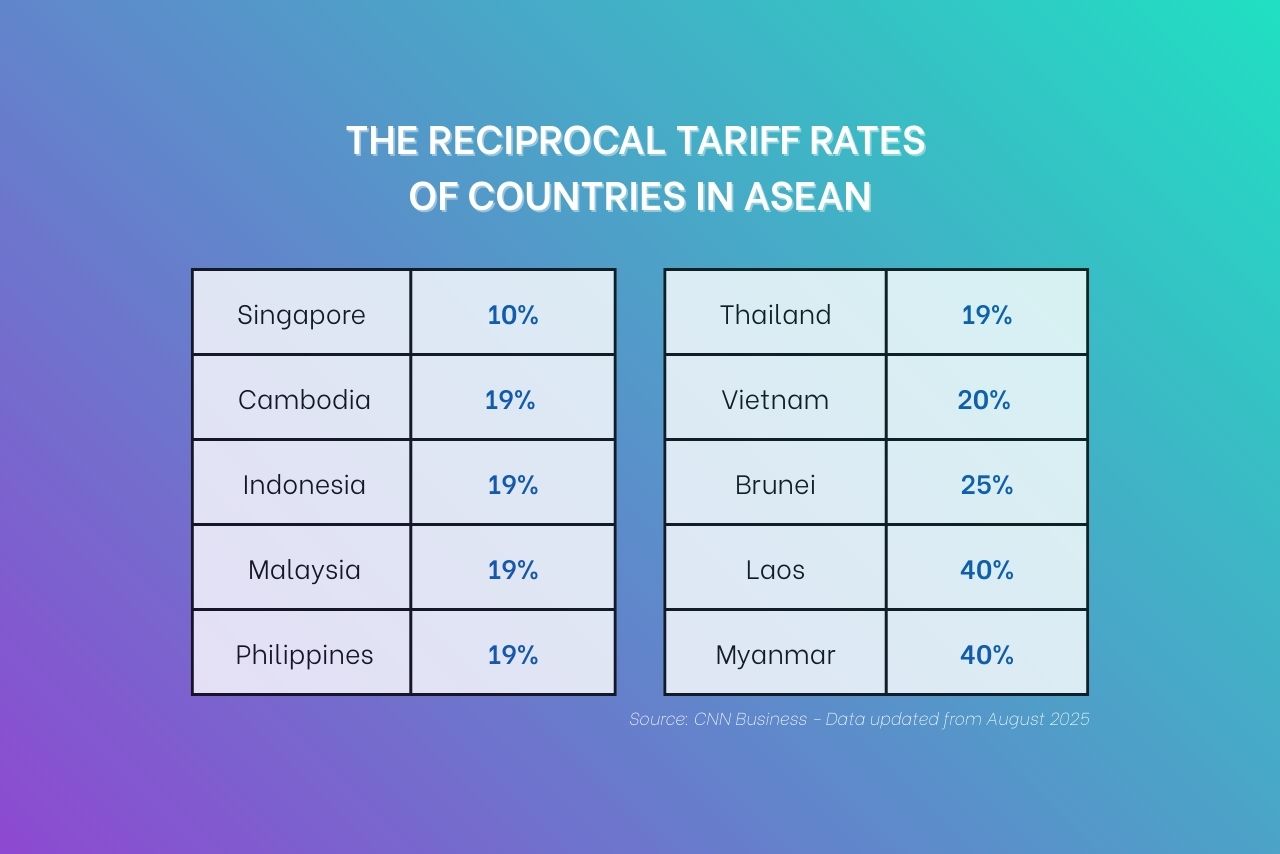
The reciprocal tariff rates of ASEAN countries. (Source: CNN Business)
Trump admitted these tariffs were used to extract concessions. He wanted manufacturing relocation to the U.S., greater access for American exports, and geopolitical leverage to isolate China.
For example, Vietnam’s tariff was first threatened at 46%. After talks, it was reduced to 20%, on the condition that any transshipped Chinese goods would face a 40% duty. Trump wields tariffs to “make a deal,” then eases them once partners concede.
For businesses worldwide, the new tariff regime is a moving target. Rates and exemptions shift with each round of bilateral talks. The message from Washington is blunt: if you want access to the U.S. market, you must make concessions or invest locally.
In short, these measures reflect the broader Trump trade war approach. The Trump tariff policy now extends beyond China and directly impacts ASEAN markets.
ASEAN governments and firms must deal with sudden tariff swings and country-by-country deals. Companies in Southeast Asia have realized that planning and staying flexible are essential under America’s shifting trade stance.
With this context in mind, the following section takes a closer look at the concrete effects of these US tariffs on ASEAN exports, examining both the hurdles and the openings they create for Southeast Asian businesses.
The impact of US tariffs on ASEAN Exports: Challenges and Opportunities
Trump’s new tariffs cast a wide net over Southeast Asia’s exports to America. The region, with economies worth more than $3.8 trillion, rushed to make concessions and negotiate with the U.S., its largest export market.
Opportunities
On one hand, the region breathed a sigh of relief when final tariff rates turned out lower than expected. Major exporters such as Thailand, Malaysia, Indonesia, the Philippines, and Vietnam all landed near-uniform 19–20% tariffs. This leveled the playing field among regional competitors.
This outcome prevented catastrophic export losses. It also meant no single ASEAN country gained a huge price edge over others. A Thai furniture maker told Reuters they were “relieved” the tariff was only 19%. Nevertheless, they feared U.S. buyers would soon push for discounts.
Moreover, tariffs may accelerate intra-ASEAN integration and diversification. This strengthens regional blocs like the RCEP. Southeast Asia can also pivot to Asian, Middle Eastern, and European markets under favorable trade deals.
Trump’s China-focused policies have indirectly benefited ASEAN. U.S. restrictions on Chinese investment redirected capital into Southeast Asia, making the region a stronger global manufacturing hub. As long as ASEAN keeps open trade and builds competitiveness, it will continue to attract manufacturing shifts.
Challenges
On the other hand, even a 19% tariff is a major new cost. Trump admits tariffs in 2025 are already being felt. For many ASEAN exporters, this means thinner margins and fewer orders. Export-reliant sectors such as electronics, machinery, and apparel now face tougher competition.
For example, Vietnam, with a $120+ billion trade surplus with the U.S., must now handle a 20% cost increase on shipments. This could slow its rapid export growth, which hit $405.5 billion in 2024. Smaller ASEAN economies such as Laos and Myanmar face even harsher 40% tariffs. They risk steep export declines and job losses if those rates remain.
Economists also note the impact of tariffs on the U.S. economy in 2025. Tariffs do not just hit exporters; they hit American wallets. A 19% duty on an ASEAN-made laptop could add about $100 to the retail price. For families already stretched by inflation, that is a real bill, not an abstract policy fight.
Still, U.S. tariffs in 2025 create a dual challenge for Southeast Asia. They bring short-term pain as exports grow costlier. Yet they also push the region to take a bigger role in U.S. supply chains at China’s expense.
Given these challenges and opportunities, the next section explores what concrete actions ASEAN businesses can take to address the impact of U.S. tariffs.
Explore now how South Korean businesses navigate U.S. tariffs via our detailed report.
Strategic Responses for Businesses to U.S. Tariffs
While risks are real, Trump admits tariffs also push U.S. buyers to diversify sourcing. This could boost ASEAN firms that show compliance, competitive pricing, and reliable supply chains. Below are key responses companies should consider:
Diversify sourcing & markets
Reduce reliance on the U.S. by expanding into other markets. Use intra-Asian trade and agreements like RCEP and CPTPP to find new buyers. As a result, exporters become less vulnerable if U.S. tariffs tighten.
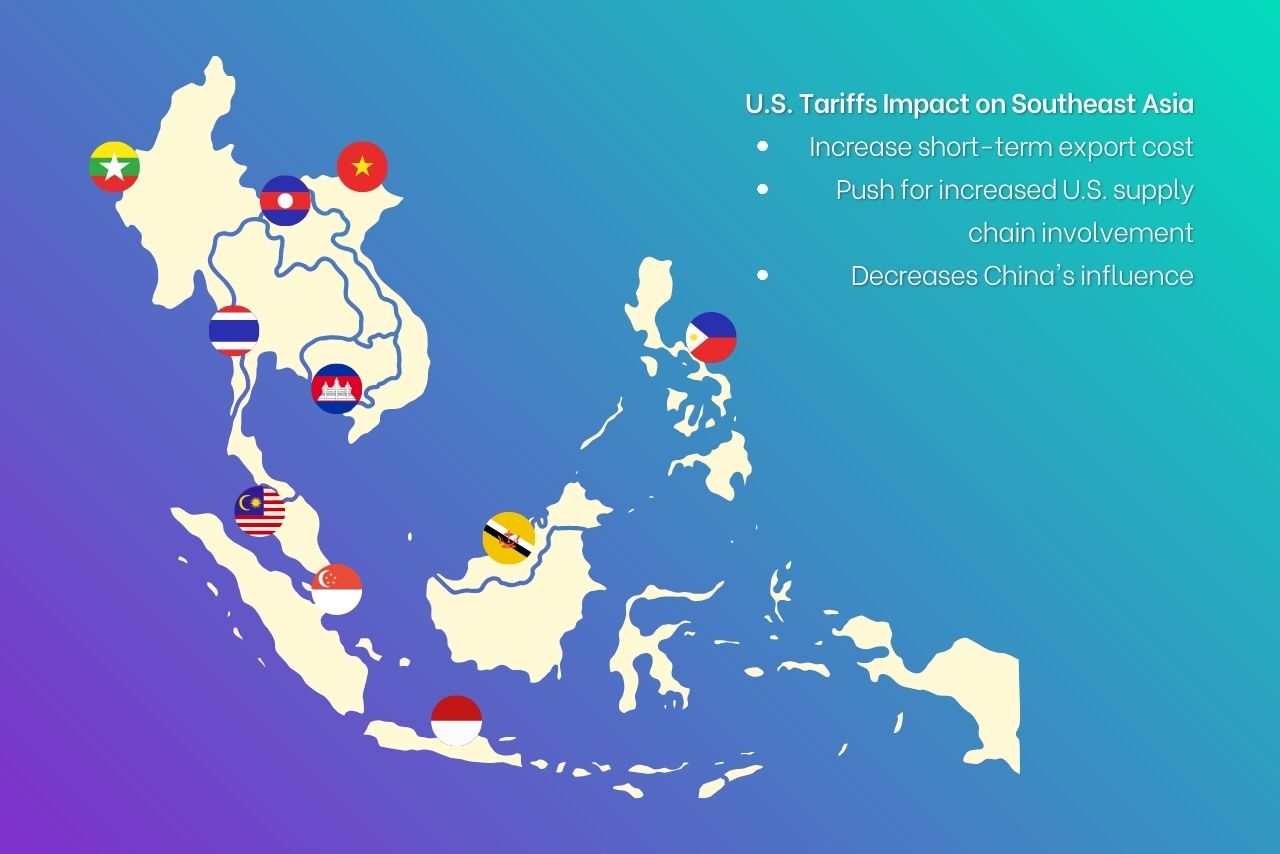
The U.S. tariffs’ impact on Southeast Asia countries.
Enhance value and compliance
Move up the value chain to make products worth higher prices. Focus on quality and design so U.S. buyers accept added costs. At the same time, ensure strict compliance with U.S. trade rules to keep access.
Vietnamese firms, for instance, must verify local content and avoid routing Chinese goods through Vietnam. Doing so could trigger a 40% penalty. Meeting new labor, environmental, and original standards is critical for long-term market access.
Optimize and cut costs
To offset tariffs of about 19%, exporters must improve efficiency. Automation, lean processes, and cheaper inputs from ASEAN can help.
Governments may also support it with export incentives or currency policies. Therefore, exporters should stay alert to new measures that improve cost competitiveness.
Embrace supply chain diversification
Trump’s renewed tariffs on China speed up the “China+1” strategy. Firms spread production across ASEAN and beyond to reduce dependency.
When the “China+1” strategy goes mainstream, rising U.S. tariffs on Chinese goods encourage companies to move production to ASEAN. Vietnam, Malaysia, and Thailand stand to benefit, while Cambodia and Indonesia attract low-cost manufacturing.
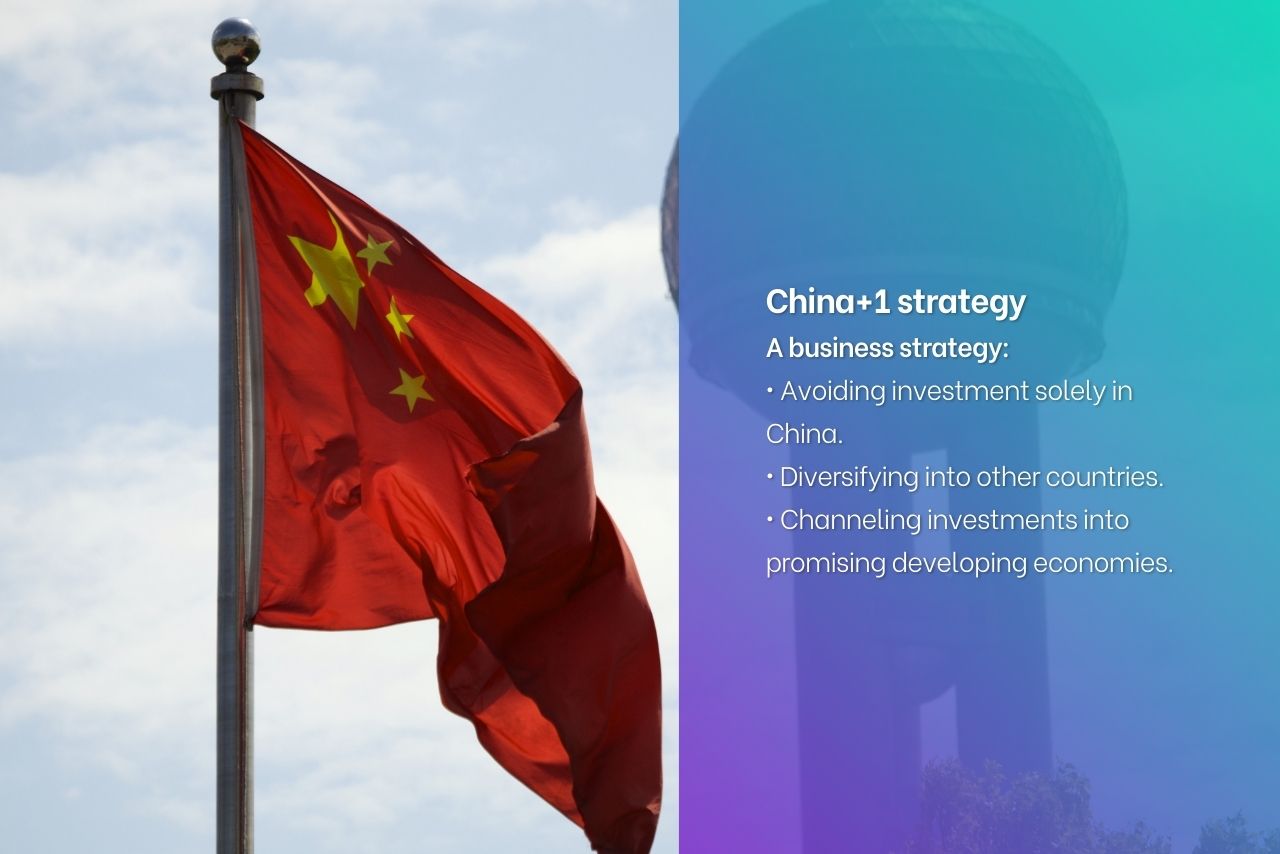
What is the China Plus One strategy?
In today’s tariff war, betting everything on one country is risky. Smart firms already use multi-country production to ensure one policy change does not block their supply chain. As one Source of Asia insight notes, companies in 2025 face unprecedented uncertainty from tariffs, and the most effective solution is supply chain diversification.
For example, if Vietnam again faced a 30% tariff, companies concentrated there would suffer heavy losses. This scenario shows why spreading risk across borders is essential.
Businesses must also consider the China–U.S. tariffs’ wider impact. In addition, they should reduce dependency on sectors most exposed to tariffs.
Partner with regional experts
Navigating many regulations and cultures is complex. This is where a partner like SOA adds value. We provide support in ASEAN, from supplier scouting to market entry consulting and compliance advisory.
For example, a firm diversifying to Vietnam or the Philippines can rely on SOA to handle registration, connect with suppliers, and navigate customs. In an uncertain era, having local experts is critical.
Businesses must understand the broader China–U.S. trade tariffs impact as they diversify supply chains and avoid overexposure to one market.
By adopting these strategies, businesses can turn a challenge into an advantage. Firms that diversify now will be better prepared not only for tariffs but also for other disruptions, such as pandemics or conflicts.
Check the SOA Flyer for more strategic responses for ASEAN countries now.
Trump’s Tariff and Considerations for U.S. Investors in ASEAN
While tariffs make headlines, U.S. investors should not ignore ASEAN’s strong fundamentals. The region remains one of the most dynamic markets worldwide. Its growth is driven by a young population and fast digital adoption.
U.S. companies can also benefit from supply chain realignment. Multinationals are moving production into ASEAN because of tariffs on China and ASEAN itself. This shift opens doors for investment in factories, logistics, and supporting industries in Vietnam, Thailand, and Indonesia.
At the same time, U.S. investors can use ASEAN’s web of trade deals. Producing in ASEAN and exporting to nearby markets helps hedge against U.S. tariff risks.
Investors should also focus on sectors less exposed to tariffs, such as services, fintech, and the digital economy. These areas are booming in ASEAN’s young and connected populations.
Conclusion
Trump’s 2025 tariffs cut both ways for Southeast Asia. Yes, exporters face steeper barriers. But the region’s location, its trade deals, and its rising role in global supply chains also open new doors.
For companies looking to expand or adapt in ASEAN, Source of Asia is your trusted partner. We help firms build resilient strategies and capture growth. Whether you need to understand new U.S. trade rules, find a manufacturer in Vietnam, or plan entry into Thailand or Indonesia, our team is here to guide you.
FAQs
Yes. Trump’s new tariffs directly affect ASEAN exporters. Tariffs of 10–20% (or more) make Southeast Asian goods more costly in the U.S. market. As a result, American importers may cut orders if prices rise too much. Countries like Vietnam, Malaysia, and Thailand are already feeling pressure. In addition, ASEAN could suffer indirect effects if global trade slows or if China diverts its exports into ASEAN markets. These tariffs are part of Trump’s broader America First policy, often compared to the earlier Trump trade war.
Electronics and machinery top the list. They account for about 28% of ASEAN exports to the U.S. Items like semiconductors, computers, and phones now face extra duties, hitting exporters in Malaysia, Vietnam, the Philippines, and Thailand.
In addition, textiles and apparel remain highly vulnerable. The U.S. buys large volumes of clothing and footwear from Vietnam, Indonesia, and Cambodia. These categories already make up around 6% of ASEAN–U.S. trade and were hit with new tariffs.
To minimize the impact of U.S. tariffs on global trade, ASEAN businesses should adopt several strategies:
- Diversify markets. Do not rely only on the U.S. Explore Europe, East Asia, and intra-ASEAN demand to reduce dependency.
- Move up the value chain. Focus on quality and design so buyers accept higher prices.
- Use trade agreements. Apply FTAs and preference schemes to cut input costs and improve access.
- Share costs. Work with U.S. importers to split tariff expenses through new contract terms.
- Ensure compliance. Avoid penalties by meeting labeling, origin, and customs rules.
- Shift production. If one country faces harsher tariffs, move some operations to neighbors with lower duties.
- Stay informed. Policies can change fast. Therefore, businesses should monitor USTR and WTO updates.
Finally, engage trusted advisors like SOA to adjust strategies quickly and avoid costly mistakes.
Doing business in ASEAN in 2025–2026 means tapping into a dynamic but diverse region. Each country has its own regulations, taxes, and business culture. Therefore, careful research is critical.
- Leverage integration. Once you are in one ASEAN market, you can often expand to others thanks to regional trade deals.
- Build relationships. Business in ASEAN relies on trust and networks, so local partners and managers are vital.
- Use support programs. Governments and organizations provide help for foreign investors, such as BOI in Thailand or MIDA in Malaysia.
In short, ASEAN offers major opportunities, but success requires preparation, local knowledge, and reliable guidance.
Explore more insights from Source of Asia:
- The EU–Vietnam Free Trade Agreement continues to boost cross-border trade. As a result, both sides enjoy lower tariffs, broader market access, and greater investment confidence.
- Vietnam remains a key choice in global supply-chain diversification. In addition, strong infrastructure and investor-friendly policies make it a reliable production base.
- The upcoming SelectUSA ASEAN Roadshow highlights new investment opportunities. Meanwhile, it strengthens U.S.–Vietnam cooperation and expands FDI partnerships across the region.
- Through a decade of collaboration, Source of Asia and Globallians have built bridges for global companies entering Southeast Asia. Explore now!
- SOA’s CEO shared practical insights on export promotion and investment attraction during the SIDO 2025 Best Practices & Training Conference.
